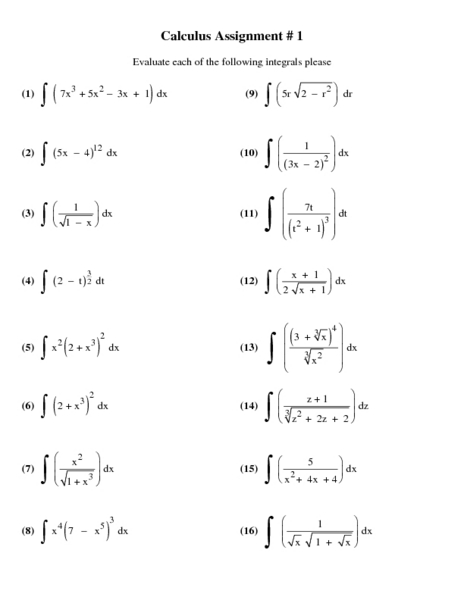
- #AP CALCULUS PRACTICE PROBLEMS HOW TO#
- #AP CALCULUS PRACTICE PROBLEMS FULL#
- #AP CALCULUS PRACTICE PROBLEMS FREE#
These four questions represent just a small fraction of the possible types of questions that can be asked on the AP exam. Always remember, if a question is asking something about the physical world, ask yourself the question ‘does the answer make sense?’ If you get answers that seem ridiculous, go back over your work. We can throw out the negative case because it has no physical meaning in this problem. In this case, take derivative of V and set to 0. We know w = l, so we can use this to simply the first two equations:Īny maximization or minimization, we are going to take the derivative and set to zero. If we’re ever not sure, first step is always to draw out the situation:

This problem is an optimization problem, similar to the last one. What are the dimensions for a box with the maximum volume? Let’s say we want to make a three-dimensional box with a square base (l=w), but we want the surface area to be no greater than 10 m^3. We are asked for dimensions - The fence is 25m x 12.5m 4. If we put these numbers back into the constraint: As in all maximum/minimum value problems, we find the derivative. We are asked to find the maximum value of A. We put this into the area equation to give:Īt this point, we should go back to the constraint and figure out the domain of y. We can rewrite the constraint as one function of another. We need to maximize A = xy with the constraint 50 = x + 2y. Optimization problem will almost always have two functions involved in this case the two functions involve area and perimeter. These are the only two properties which change. The variables in this problem are the lengths of x and y. Visualizing the problem often helps in finding the correct governing equations. It is often a good idea to sketch the situation given. This is a quintessential optimization problem. What dimensions of the fence give the largest possible area? We have 50 feet of fencing available, and a permanent straight wall of infinite length exists on one side (therefore not needing fencing). We need to enclose an area within a fence. We should see this in the graph as existing around x= – 1.25, x = 2, and x = 4 3. We should see that it is a minimum because the derivative goes from negative to positive at this point.ī) This function has a relative maximum at x = -2.5 We should see that it is a maximum because the derivative goes from positive to negative at this point.Ĭ) The inflection points exist where the second derivative is 0. Ī) Where does f(x) have a relative minimum?ī) Where does f(x) have a relative maximum?Ĭ) If f(x) has an inflection point, approximately where does it lie?Ī) This function has a relative minimum at x = 0. t = 5.76 is one of several possibilities. The initial time, t=0 gives us a position: x(0) = 0-cos(0)-.839 = -1.839ĭ) Simply find a root for our initial equation for velocity. To solve for c, we need to know one point: At time t=10, the car is at a position x = 5. Therefore, the object is slowing down.Ĭ) Now we need to take the indefinite integral to get a function of position.
#AP CALCULUS PRACTICE PROBLEMS HOW TO#
However you should learn how to use you graphing calculator to do this question because many integrals will be far more difficult.ī) Slowing down and speeding up are questions about whether or not the acceleration is positive or negativeĬos(t) is negative when t = 10. This is an integral that can easily be done by hand. The total displacement therefore in the integral of the velocity function between the bounds given Ī) What is the total displacement of the car between the times t = 0 and t=5ī) At time t = 10, is the car slowing down, or speeding up?Ĭ) What is the position of the particle at the initial time?ĭ) Find a time when the velocity equal to 0.Ī) Whenever we have a velocity question, we should think back to the following relationships: At time t=10, the car is at a position x = 5. Its velocity can be modeled by the equation. An object moves back and forth across the x-axis.
#AP CALCULUS PRACTICE PROBLEMS FREE#
AP Calculus AB Exam Free Response Practice Problems 1. These only represent a small fraction of the types of questions that might come up on an AP Calculus AB Exam the more problems you can do before the exam, the better prepared you will be.
#AP CALCULUS PRACTICE PROBLEMS FULL#
Here is a handful of AP Calculus Free Response style practice problems that you can work through, along with the full solutions.

One of the best ways to study for the AP Calculus Free Response Questions is to practice with as many AP exam style problems as you can.


 0 kommentar(er)
0 kommentar(er)
